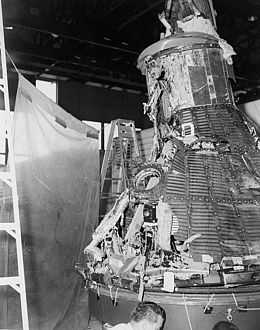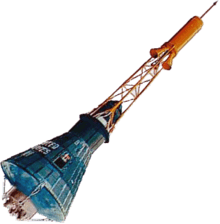Mercury-Atlas 1
 The reconstructed MA-1 spacecraft after debris recovery | |||||
| Mission type | Test flight | ||||
|---|---|---|---|---|---|
| Operator | NASA | ||||
| Mission duration |
3 minutes, 18 seconds Launch failure | ||||
| Distance travelled | 9.7 kilometres (6 mi) | ||||
| Apogee | 13.0 kilometres (8.1 mi) | ||||
| Spacecraft properties | |||||
| Spacecraft | Mercury No.4 | ||||
| Manufacturer | McDonnell Aircraft | ||||
| Launch mass | 1,154 kilograms (2,544 lb) | ||||
| Start of mission | |||||
| Launch date | July 29, 1960, 13:13 UTC | ||||
| Rocket | Atlas LV-3B 50-D | ||||
| Launch site | Cape Canaveral LC-14 | ||||

| |||||
Mercury-Atlas 1 (MA-1) was the first launch attempt of a Mercury capsule (not including the boilerplate spacecraft of the September 1959 Big Joe flight) launched at 13:13 UTC on July 29, 1960 from Cape Canaveral, Florida. The Mercury spacecraft was unmanned and carried no launch escape system. The mission was to conduct a suborbital test flight and reentry of the spacecraft. The capsule had live posigrade separation rockets, but dummy retro rockets.
The Atlas rocket suffered a structural failure 58 seconds after launch. The vehicle at that time was at approximately an altitude of 30,000 feet (9.1 km) and 11,000 feet (3.4 km) down range when it was passing through Max Q and all telemetry signals suddenly ceased. Because the day was rainy and overcast with thick clouds, the booster had been out of sight from T+15 seconds and it was impossible to see what happened. A number of Mercury engineers had voiced their objection to launching on July 29 because of the weather precluding visual coverage of the flight. Some observers claim to have heard an explosion, but this could not be verified. The capsule continued transmitting until it impacted the ocean. Subsequent salvage attempts dredged it and the Atlas's booster engines and LOX vent valve from the ocean floor.
Telemetry indicated that the Atlas functioned normally until about T+57 seconds and there was no sign of any problems up to that point, when a severe axial disturbance was detected. Approximately one second later, the pressure level in the Atlas's RP-1 tank dropped to zero followed by loss of engine thrust and telemetry and the appearance of multiple objects on radar. Capsule data indicated violent movements following loss of booster telemetry, but the Mercury otherwise continued functioning normally until impact with the ocean at around 220 seconds after launch. The automatic abort system appeared to have functioned correctly and issued a shutdown command to the Atlas's engines the moment that it detected an abnormal situation. The parachute system did not deploy because the abort had taken place too early in the launch.
NASA's Owen Maynard, who was involved in Mercury systems engineering, led the recovery of the MA-1 capsule from the sea-floor (in which he performed a 30-foot free-dive to find one particular missing component of the capsule). He stated in an official interview that his post-flight calculations showed the skin of the launch vehicle just below the spacecraft would have buckled, due to the combined drag and bending loads at the max-Q point exceeding the tensile stress in the skin due to internal pressure. Based on that finding, the NASA specified that future Mercury-Atlas launch vehicles add doublers to the skin structure in that area, and that future launch trajectories be shallowed to reduce pitch angle rate, to reduce the bending stress on the launch vehicle. This failure mode did not recur on those subsequent launches.
The capsule reached an apogee of 13 km and flew 9.6 km downrange. The flight lasted 3 minutes and 18 seconds. Capsule weight 1,154 kg. Serial numbers: Atlas 50-D, Mercury spacecraft #4.
Pieces of Mercury spacecraft #4, used in the Mercury-Atlas 1 mission, are currently displayed at the Kansas Cosmosphere and Space Center, Hutchinson, Kansas.[3]
Notes
![]() This article incorporates public domain material from websites or documents of the National Aeronautics and Space Administration.
This article incorporates public domain material from websites or documents of the National Aeronautics and Space Administration.
References
| ||||||||||||||||||||||||||||||||||||||||||||||||||||||||||||||||||
